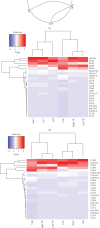A Survey of Fatty Acid Content of the Male Reproductive System in Mice Supplemented With Arachidonic Acid
- PMID: 39734583
- PMCID: PMC11671656
- DOI: 10.1155/jl/3351340
A Survey of Fatty Acid Content of the Male Reproductive System in Mice Supplemented With Arachidonic Acid
Abstract
Paternal exposure to high-fat diets or individual fatty acids (FAs) including arachidonic acid (AA) modifies progeny traits by poorly understood mechanisms. Specific male reproductive system FAs may be involved in paternal inheritance, as they can modify a range of cellular components, including the epigenome. Our objective was to determine FAs in compartments of the male reproductive system that potentially affect ejaculate composition-right and left testicular interstitial fluid (TIF), vesicular gland fluid (VGF), and epididymal adipose tissue (EAT)-in mice exposed to AA or vehicle daily for 10 days (n = 9-10/group). Whole blood (WB) and interscapular brown adipose tissue (IBAT) FA profiles were used as reference. AA significantly affected only VGF FAs relative to vehicle, that is, increased and decreased levels of arachidic and docosahexaenoic acid, respectively, versus vehicle (0.28% ± 0.01% and 0.23% ± 0.03%, respectively, p = 0.049, and 2.42% ± 0.47% and 3.00% ± 0.58%, respectively, p = 0.041). AA affected distinct FAs in WB. Additionally, we uncovered AA-dependent and AA-independent FA laterality. Myristic acid was higher in AA-exposed left versus right TIF (0.68% ± 0.35% and 0.60% ± 0.11%, respectively, p = 0.004). Right TIF contained higher oleic and linoleic acid and lower stearic acid than left TIF (29.01% ± 3.07% and 24.00% ± 2.18%, respectively, p = 0.005; 9.14% ± 1.88% and 7.05% ± 1.36%, respectively, p = 0.005; and 21.90% ± 2.92% and 26.01% ± 2.46%, respectively, p = 0.036), irrespective of exposure to AA. The TIF oleic/stearic acid ratio suggested higher Stearoyl-CoA Desaturase 1 activity in the right versus the left testis (1.35 ± 0.32 and 1.00 ± 0.17, respectively, p = 1.0 × 10-4). Multitissue comparisons revealed that TIF and VGF FA profiles were distinct from WB, EAT, or IBAT counterparts, suggesting tissue-specific FA fingerprints. In conclusion, AA modulated selected VGF long-chain FAs that may impact on uterine inflammation and subsequent embryonic development. AA altered local FA synthesis or selective uptake, rather than eliciting passive uptake from WB. Additionally, we uncover a significant laterality of testis FAs that may result in asymmetric sperm cell phenotypes.
Keywords: arachidonic acid; fatty acid; male reproductive system; paternal transmission.
Copyright © 2024 Viridiana Abigail Correa-Navarro et al.
Conflict of interest statement
The authors declare no conflicts of interest.
Figures



Similar articles
-
Cumulative Metabolic and Epigenetic Effects of Paternal and/or Maternal Supplementation with Arachidonic Acid across Three Consecutive Generations in Mice.Cells. 2022 Mar 21;11(6):1057. doi: 10.3390/cells11061057. Cells. 2022. PMID: 35326508 Free PMC article.
-
Effects of paternal arachidonic acid supplementation on offspring behavior and hypothalamus inflammation markers in the mouse.PLoS One. 2024 Mar 21;19(3):e0300141. doi: 10.1371/journal.pone.0300141. eCollection 2024. PLoS One. 2024. PMID: 38512839 Free PMC article.
-
Plasma fatty acid composition, estimated desaturase activities, and their relation with the metabolic syndrome in a population at high risk of cardiovascular disease.Clin Nutr. 2014 Feb;33(1):90-7. doi: 10.1016/j.clnu.2013.03.001. Epub 2013 Mar 28. Clin Nutr. 2014. PMID: 23591154
-
Effect of dietary lipids and endocrine changes on polyunsaturated fatty acids in phospholipids of pancreas and brown adipose tissue of obese and lean rats.Comp Biochem Physiol Physiol. 1994 Oct;109(2):235-44. doi: 10.1016/0300-9629(94)90126-0. Comp Biochem Physiol Physiol. 1994. PMID: 7956117
-
Human milk fatty acid profile across lactational stages after term and preterm delivery: A pooled data analysis.Prostaglandins Leukot Essent Fatty Acids. 2020 May;156:102023. doi: 10.1016/j.plefa.2019.102023. Epub 2019 Oct 16. Prostaglandins Leukot Essent Fatty Acids. 2020. PMID: 31699594 Review.
References
LinkOut - more resources
Full Text Sources
Research Materials
Miscellaneous

